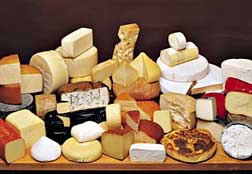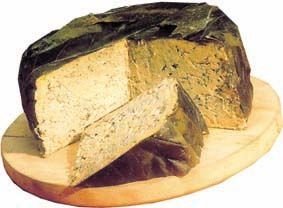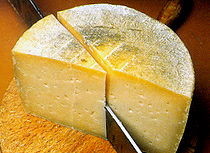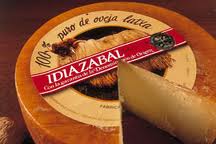Spanish Cheese
Spain has a vast gastronomical culture and for the Spanish, cheese is not just food, it's almost a religion. Throughout history the many civilizations that have settled or passed through Spain, the different regional customs, climates and topography have each contributed to create in Spain an ample cheese tradition, of which more than 200 types have sprung.

Goat's, cow's and sheep's milk are used in the elaboration of Spanish cheese. Some of the varieties are perhaps hardly known out of their city or region, but many have gained world renown and some even have Designation of Origin. All quality and production procedures of denominación de origen certified cheeses are highly regulated and they can only be produced in its own region. For instance Cabrales cheese can only be elaborated in the Cabrales region in Asturias and on 90% of the cases, only the milk on animals bred and fed in the region can be used.
Abundant farms still maintain the tradition of producing cheese by hand, though the mass manufacture is becoming ever more popular. Many convents in different Spanish cities and farms keep centuries old recipes and make cheese the same way it was done in the Middle Ages.
The most typical way that Spaniards enjoy cheese is the famous tabla de quesos (cheese board), where a selection of cheeses are cut and placed on a board and the diners pick medium sized pieces that are eaten on crackers or alone. It's very common to order cheese boards and wine in bars.
However the best way to try the many delicious cheeses is in Spain itself. Many people travel to the country to take learn Spanish in Spain and get the best taste of Spanish gastronomy.
Many people also enjoy light Spanish cheese in deserts such as cheese and honey and cheese and quince. There are also some cakes made with cheese, such as Flaó, typical from Ibiza, made with cow's and goat's milk.
However the limit is the imagination. Some people love to put cheese slices on top or inside Spanish tortillas so they'll have that lovely texture that only melted cheese can give, or the typical cheese sandwiches and tapas that are made at home or served in bars along with a caña (small glass of lager).
There are many ways to classify cheese, aside from the type of animal whose milk is used, one of the most common is the type of milk used
- Raw milk: the milk used is not heated over 40º C (104º F) or subjected to treatments that will cause a an effect similar to heat.
- Pasteurized milk: cheese elaborated milk that is heated to a temperature between 72ºC (161ºF) and 76ºC (168.8ºF) for 15 second followed by an immediate cooling.
- Sterilized milk: the milk used for the elaboration has had a consistent thermic treatment and immediate cooling.
- Micro-filtered milk: the milk is separated from the cream and then the skimmed milk is filtered through very thin tissues that capture bacteria. This milk is next mixed with the cream in adequate proportions.
Ten top Spanish cheese:

- Cabrales cheese: this blue cheese can be elaborated with goat's, sheep's or cow's milk. Of a bluish-green crust and a creamy yellowy interior and very strong taste and smell. It is only produced with handmade techniques. D.O. Cabrales, Asturias.
- Mahon cheese: This cow's milk cheese has been produced by local farmers for centuries. Although it has a milky, flowery and sweet aroma its flavor comes as a surprise, as its acrid and slightly sour, with a reminiscence of toasted nuts and toffee. D.O. Menorca
- Burgos cheese: this white cheese can be made with cow's, sheep's or goat's milk. Its has a very light taste, with flavors of fresh milk with a touch of acidity and salt. Spaniards eat it in salads, in deserts with sugar and honey and some people like to fry it. D.O Burgos, Castilla y León.

- Manchego cheese: elaborated with pasteurized sheeps' milk. Its tradition dates back to Roman times, though today it's produced by farmers or large cooperatives. The taste is slightly acidic, strong and rich, in very cured cheese it becomes spicy. D.O. La Mancha, Castilla y la Mancha.
- Tetilla cheese: elaborated with cow's milk. It's named for its resemblance to a female breast. It has a thin yellow crust and the interior is a creamy and uniform paste. The taste is light, buttery and with a touch of salt. D.O. Galicia.
- Torta del Casar: elaborated with raw sheep's milk. Perhaps the most expensive Spanish cheese. Still a handmade product, following the same methods used hundreds of years ago. It has a semi-hard crust with a yellowy ochre color. Inside the paste is soft and creamy. This cheese has an intense smell and strong taste, with a soft bitter touch due to the use of vegetable rennets. D.O. Extremadura.
- Murcia cheese passed through wine: elaborated with pasteurized goat's milk. The crust is smooth and light and washed twice in red wine from the region. Inside the mass is compact with a creamy and elastic texture. It has a medium taste, slight acidic and salty. Spaniards enjoy it with tomato salad or as a tapa, perhaps with olive oil and red and green peppers. D.O. Murcia.
- Arzua Ulloa cheese: elaborated with cow's milk either raw or pasteurized. It has a strong taste with sweet touches and creamy to the palate. Suitable for all tastes. D.O. Galicia.

- Idiazabal cheese: elaborated with sheep's milk. It has been declared gastronomic patrimony by the European Union. With a hard yellow crust and dark brown when smoked. The interior is compact and its color varies from from white to ivory yellow. The taste is intense, consistent with a strong flavor of matured sheep's milk. With spicy touches. D.O. Basque Country and Navarra.
- De La Serena cheese: made with sheep's milk. This cheese is soft and creamy, with a waxy ivory color covered by a semi-hard crust. The taste is slightly bitter, not acidic and very lightly salty. Considered one of Extremadura's best cheese. D.O. Extremadura.
So whether in salads, Spanish tapas, in the classic bocatas and bocadillos (sandwiches) or on different dishes, there's Spanish cheese for all tastes. If you ever come to Spain, be sure to try different kinds and choose your favorite!




